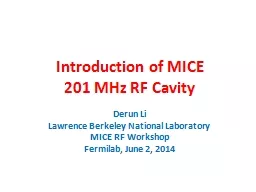

Derun Li Lawrence Berkeley National Laboratory MICE RF Workshop Fermilab June 2 2014 MICE MICE RF Workshop June 2 2014 Fermilab Derun Li LBNL Our responsibilities in MICE cooling channel ID: 788387
Download The PPT/PDF document "Introduction of MICE 201 MHz RF Cavity" is the property of its rightful owner. Permission is granted to download and print the materials on this web site for personal, non-commercial use only, and to display it on your personal computer provided you do not modify the materials and that you retain all copyright notices contained in the materials. By downloading content from our website, you accept the terms of this agreement.
Slide1
Introduction of MICE 201 MHz RF Cavity
Derun Li
Lawrence Berkeley National Laboratory
MICE RF Workshop
Fermilab, June 2, 2014
Slide2MICEMICE RF Workshop, June 2, 2014 (Fermilab), Derun Li, LBNL
Our responsibilities
in
MICE cooling channel:
2
RFCC modules (eight 201-MHz cavities) (Step-6) 2 spectrometer solenoids (delivered)
Demonstration of muon ionization cooling
International MICE experiment at RAL
RFCC
RFCC
SS
SS
Slide3The RFCC ModuleMICE RF Workshop, June 2, 2014 (Fermilab), Derun Li, LBNL
Sectional view
of RFCC module
tuner
Cavity fabrication
Beryllium window
Coupler
Design and fabrication progress
Slide4RF Design of the Cavity
The cavity design parameters
Frequency: 201.25 MHz
β
= 0.87Shunt impedance (VT2/P): ~ 22 MΩ/mQuality factor (Q0): ~ 53,500Be window diameter and thickness: 42-cm and 0.38-mmNominal parameters for MICE and cooling channels in a neutrino factory
8 MV/m (~16 MV/m) peak accelerating field
Peak input RF power: 1 MW (~4.6 MW) per cavity
Average power dissipation per cavity: 1
kW (~8.4 kW)Average power dissipation per Be window:
12 watts (~100 watts)
MICE RF Workshop, June 2, 2014 (Fermilab), Derun Li, LBNL
Slide5MICE RF CavityMICE RF Workshop, June 2, 2014 (Fermilab), Derun Li, LBNL
Cavity
has been tested
successfully at MTA
Slide6Fabrication Development of Cavity
42-cm
Cavity fabrication technique development, in collaboration with
JLab
; First prototype cavity has been high power tested at MTA, Fermilab
MICE RF Workshop, June 2, 2014 (Fermilab), Derun Li, LBNL
Slide7Single Cavity Vessel
The
v
essel is made by Keller Technology, and
is currently at Fermilab.
MuCoolCC coil
Tuners &Tuning mechanism
Same features RFCC module would have
MICE RF Workshop, June 2, 2014 (Fermilab), Derun Li, LBNL
Slide8Single Cavity Vessel (cont’d)
MICE RF Workshop, June 2, 2014 (Fermilab), Derun Li, LBNL
Slide9First RFCC Module - Status
MICE RF Workshop, June 2, 2014 (Fermilab), Derun Li, LBNL